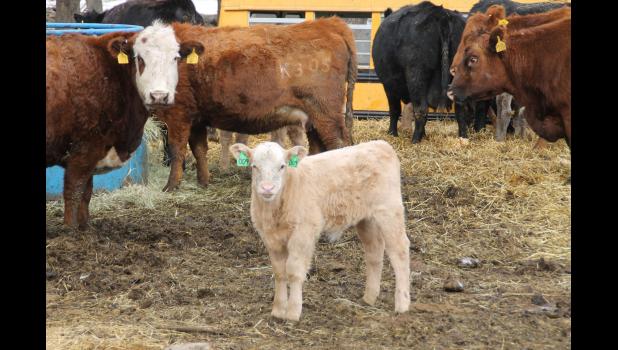CALVING: MINIMIZE PERSONAL RISK
No matter what time of year producers calve, there are practices that help improve personal safety during the process.
Both assisting cows with calving or tagging newborn calves can pose significant risk for personal injury during any kind of weather conditions.
“There’s no process in place to document how many people have been injured while trying to tag a calf,” Aaron Berger, University of Nebraska South Panhandle Extension Unit, says. “Cows are usually unhappy about it, and there are some things that can be done to minimize the risk.”
Berger advises that producers consider the necessity of immediately tagging a calf. Since observing which cow claims a calf, tagging may be deferred until the cow is less irritable or weather conditions are more accommodating.
“For instance, during branding season, it’s obvious which calf is nursing a cow and tagging can be completed at that time,” Berger says. “Cows could also be brought in once the cows is more settled so tagging can be completed more safely.”
If a cow needs to be restrained, Berger advises against using a rope attached to a bumper. The safest way to handle an animal is in a facility designed for that purpose.
“Bringing a cow or cow and calf in at any time raises the level of risk for the producer,” Berger says. “You’re usually moving fast and it’s easy to overlook the hazards around you. Use the proper head catch panels that fold out to correctly assist a cow. With a squeeze chute, an animal can go down and injure themselves.”
Regularly practicing sound livestock handling practices will help diminish the chances that a cow will injure a producer. Learning to read the behavior of cows and understanding signs that they are ready to charge. An arched back and lowered head can be an indication of significant agitation.
“If you have to bring a cow in, make sure your facilities are in good condition,” Berger says. “Check gate latches and look for any area that might need repair. There may also be times when bringing a cow in poses too big a threat to the producer. No one wants to lose an animal, but if a facility is torn up or someone gets hurt, there’s a great cost to that, too.”
Regularly inspecting a calving facility prior to calving season can be a valuable exercise in safety. Maintenance on items such as headgates and lighting can be accomplished well ahead of calving, making the season safer for producers and cows.
In evaluating the risk of handling an agitated cow, producers might consider the risk of sustaining a lifelong injury.
“In the heat of the moment, we sometimes think, we’re not going to let that cow get the best of us,” Berger says. “But injuries incur costs, too. If a producer can’t work for the remainder of the calving season or suffers injury that affects them for the rest of their life, that is a very high cost. It’s possible that it’s best not to keep a cow with that attitude.”
Winter calving often involves ice and snow, increasing potential for injury while working around cows and calves. In muddy conditions, rutted pastures or areas also pose additional hazards.
“When it’s cold, we have more clothes on when we’re working outside, too,” Berger says. “It’s likely that we’re not able to move as quickly to respond to a threat during those kinds of conditions. Working in icy conditions or operating equipment on ice also enhances the risk of injury.”
During times when temperatures are frigid and fatigue may affect producers, tasks such as checking cattle during the night hours or assisting a cow on snowpack or ice can quickly become hazardous. Use of four wheelers or horses during these conditions poses its own set of risk for injury.
Anytime a producer assists a cow with calving there’s risk of injury to the lower back and neck. Injury can be incurred by straining muscles, being kicked or butted by the cow, etc. Other hazards related to calving are uneven ground, sharp objects, vehicles, fences or railings. Ankle strains and eye injuries may also occur.
Maintaining fitness and strength during the off-season, getting enough sleep and staying hydrated will help avoid physical injury. Minimizing the distance calves or heavy objects are carried during the calving process and taking a break when possible will also lessen the possibility for personal injury.
To help avoid nighttime calving, Berger recommends that producers evaluate the value of research that indicates feeding cows late in the day will result in a large number of daytime births. It may be necessary to check on cows at night but avoiding calving activity at night can greatly decrease the chance of injury to producers.
“In the daytime, it’s much easier to see what’s happening with a cow and calf,” Berger says. “Temperatures tend to be warmer during the day, so calves are likely to need less assistance in getting up and nursing.
“We should take pride in managing our livestock,” Berger adds. “But we need to protect ourselves from personal loss, too.”

